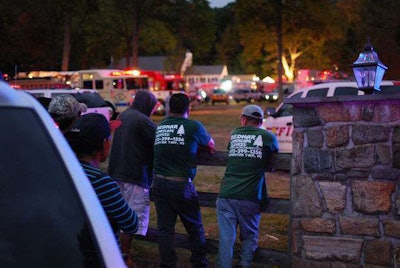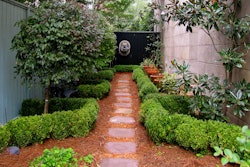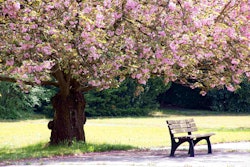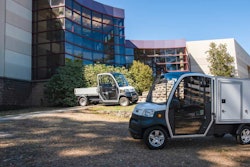 Other employees from the landscape company stood by and waited as the rescue units worked.
Other employees from the landscape company stood by and waited as the rescue units worked.Despite the accident occurring more than three years ago, the Morris County Prosecutor’s Office filed criminal charges against Bednar Landscape Services Inc., its president Keith Bednar and corporate secretary Christopher C. Liberatore.
The charge of causing or risking widespread injury or damage was filed on Jan. 9 for the death of two Bednar workers, Oscar Portillo and Selvin Zelaya, who were killed on Oct. 1, 2014.
The company’s attorney John O’Reilly entered a guilty plea for the company on Jan. 17. The charge is a fourth-degree offense and could lead to up to 18 months in prison if convicted, but the Morris County Prosecutor’s Office is not seeking jail time for the corporate officers.
The state has recommended a punishment of a $50,000 fine against the company that will be distributed among Portillo’s three and Zelaya’s two children.
The fatal accident occurred when the two workers were digging a trench around the foundation of a customer’s home in Boonton Township, New Jersey, for a French drain installation.
One side of the trench was supported by the house foundation, but the other side was not properly shored up and collapsed. The trench was between nine and 13 feet deep and had no cave-in protection.
The Occupational Safety and Health Administration (OSHA) investigated the site and fined Bednar $77,000 for one willful and nine serious safety violations.
“The willful citation was due to the trench not being adequately sloped, protected by shields or shoring,” the OSHA report said, according to Daily Record. “A willful violation is one committed with intentional, knowing or voluntary disregard for the law’s requirement, or with plain indifference to worker safety and health.”
OSHA’s investigation found photos of the workers at the site with the trench walls well above their heads and the bottom of the trench was filled with mud or muck. It is alleged that Keith Bednar and Liberatore were cognizant of the lack of stability of the trench.
As mud filled the bottom of the trench due to its depth, Keith Bednar rented a muck pump and discharge hose at 10 a.m. on Oct. 1, 2014. Liberatore was also on site a few hours before the cave-in and allegedly knew of the trench’s condition.
Rescue workers were dispatched at 3:50 p.m. on the same day after the homeowner reported two workers were trapped under dirt in the trench. Portillo had been using the muck pump at the bottom of the trench when it collapsed.
Zelaya and a site foreman jumped into the trench to try to free Portillo but then the trench collapsed again, burying Zelaya as well. The foreman was able to dig himself out and climb to safety.
According to court records, Zelaya was found at 7:25 p.m. that night, eight feet below the surface, and Portillo was found at 8:15 p.m. 11 to 12 feet below.
Bednar Landscape Services paid for the funeral of the two men and O’Reilly says it is willing to pay the $50,000 fine to support their families.
There are still pending wrongful death lawsuits against the landscaping company filed by relatives of the victims.
“One cubic yard of soil can weigh as much as a small car when a trench caves-in or collapses,” said Kris Hoffman, director of OSHA’s Parsippany Area Office, after the investigation. “Without the required protections, these men had no way to escape and their heartbroken families are left to make sense of a needless tragedy.
Zelaya was 39 and survived by a son who was eight years old at the time and a daughter who was then three years old. He was not married. Portillo was 46 and also not married. He had a son who was then 26, whom he lived with and two daughters. One lived in Honduras and the other lived in South Carolina, according to court records.
Two workers are killed every month in trench collapses. Trenches 5 feet deep or greater require a protective system unless the excavation is made of entirely stable rock. If the trench is less than 5 feet, a competent person can determine if a protective system is not required.
Safe access and egress is required for employees working in trenches 4 feet or deeper and they must be located within every 25 feet of all workers.
There are several different protective systems that employers can use to protect workers including sloping, shoring, shielding and benching. Deciding which system will work best depends on factors such as soil classification, depth of cut, water content of soil, weather and climate and other operations in the area.
Below are some general tips to prevent cave-ins when trenching:
- Keep excavated soils at least 2 feet from trench edges.
- Inspect trenches at the start of each shift.
- Inspect trenches following a rainstorm or other water intrusion.
- Identify other sources that might affect trench stability.
- Keep heavy equipment away from trench edges.
For more on trenching safety, click here.









